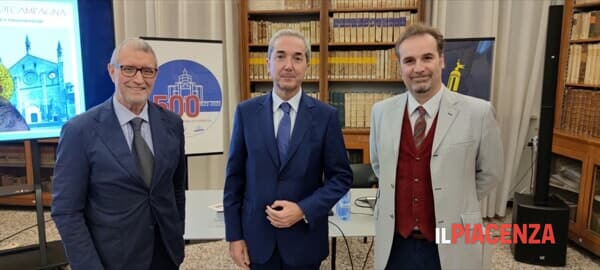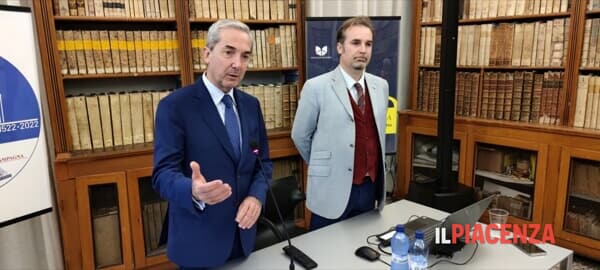On the day in which the saint of Assisi was celebrated, the first appointment of the “Franciscan October” organized by the Familia piasinteina (included in the program of the 500th anniversary celebrations promoted by the Franciscan Community and the Bank of Piacenza), concerned the two civic temples of medieval and Renaissance Piacenza: the basilicas of San Francesco and Santa Maria di Campagna unveiled, with the usual skill, to the public present at the Library of the Convent of the Friars Minor by Manrico Bissi, president of Archistiorica, who defined the two churches Franciscans “small UN of the Middle Ages and the Renaissance”, signifying the role attributed to them (and idealized) by the Piacenza community.
«The late thirteenth and early sixteenth century – explained the arch. Bissi – there were two periods of great political instability for Piacenza: first the communal struggles between Guelphs and Ghibellines, then the grueling conflicts between France, Spain and the Papacy caused our city serious economic and social turbulence, triggering the Community’s desire to find an institutional balance and harmony that could settle contrasts and hostilities ». In an era strongly permeated by spirituality and a sense of the divine, “this wish – continued the speaker – could only rely on the work of the Franciscan Order, known and esteemed for its vocation to peace and universal brotherhood. Since the thirties of the thirteenth century, the Piacenza friars of S. Francesco had earned a key role in the Free Municipality, appearing among the “great electors” who started the process for the appointment of the podestà. Their reputation as protectors of city harmony was then strengthened at the end of the century, when Franciscan mediation (promoted by Pope Gregory X) had finally led to the longed-for pacification between the Ghibelline Ubertino Landi and the local Guelph notables ».
To crown this, in 1278 the friars of S. Francesco had started the construction of their new and imposing convent, built in the center (on the square of the new bourgeois municipality) on the ruins of the houses that Landi had ceded to the Order. From that moment the great church of S. Francesco imposed itself on the large square of the city (today Piazza Cavalli) as a real “garrison” placed in defense of the political and social harmony of Piacenza: “Not by chance – underlined the president of Archistorica – its foundations arise in a barycentric place with respect to opposite polarities, namely the Guelph and popular quarter of the Scotti (S. Giovanni in Canale) and the Ghibelline and noble district of the Landi (S. Lorenzo). Since then, and for the following seven centuries, the Piacentines elected S. Francesco as the natural seat for the main civic assemblies: this happened for example in 1547, when the elders gathered in the church to approve the annexation of Piacenza to Lombardy of Charles V; and again in 1848, when the union of the city to the Kingdom of Sardinia was voted ”.
The same aspiration for peace and harmony also marked the foundation of S. Maria di Campagna, the first stone of which was laid in 1522 after the Piacentines confirmed the definitive annexation of the city to the Papacy: “This put an end to over twenty years of continuous political upheavals – the speaker continued – which had seen the succession of numerous and ephemeral Spanish and French occupations. The project of the large church, carried out by Alessio Tramello, involved the creation of an architectural organism with a Greek cross and a central plan, a concrete expression of harmony and balance between the various parts of an organism: the company was commissioned directly by the Piacenza Community, which therefore remained the owner of the building for all the following centuries until today ».
Twenty-five after the start of the works (1547), at the behest of Duke Pier Luigi Farnese, the church of S. Maria di Campagna was converted to monastic use and entrusted to the Franciscan friars Minori Osservanti, who built their own convent cloister: “Another time – concluded the arch. Bissi, much applauded by the audience present – the idea of peace and balance was therefore associated with the Franciscan religious presence. The civic destination of the church was further confirmed by the frequentation of the dukes of Casa Farnese, who elected S. Maria di Campagna as their court sepulcher: in fact, the body of Isabella Farnese (1668-1718) and the heart of her brother lie in the tombs of the choir. Francesco (1678-1727), seventh duke of Piacenza and Parma ».

“San Francesco and Santa Maria di Campagna as small medieval and Renaissance UN”

